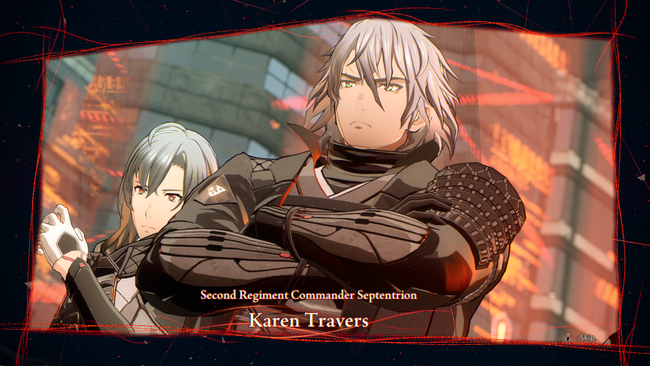
Scarlet Nexus Review
Scarlet Nexus contains just about everything you’d want to see from a new game IP. Clear ambition, innovative gameplay, gorgeous visuals, and room to improve. Out of all of these, that last one ended up sticking with me the most during my playthrough. Scarlet Nexus gets so much right for a first attempt, and it is definitely one of the best games I’ve seen from Bandai Namco in years, but imperfections are aplenty.
This is not an entirely bad thing, however. As much as we tend to boil video game criticism down to extremes, I think that mindset poisons the well of discussion. I have issues with Scarlet Nexus, the ones in question make themselves rather obvious after only a few hours of play, but this is truly greater than the sum of its parts.
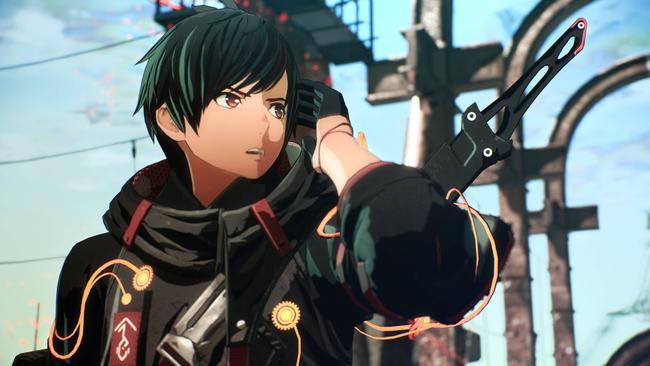
From the moment you start, you’re given a choice on which side you wish to experience the narrative. There are two protagonists: Yuito Sumeragi and Kasane Randall. While they share some similarities in their personality, how they approach the main conflict differs greatly. To understand the whole story, you’ll need to play both routes. They both are residents in the city of Suoh, and new recruits of the OSF (Other Suppression Force). ‘Others’ are the mysterious monsters that threaten the inhabitants of earth in this brain-punk alternate reality. Almost every human is born with special powers, such as pyrokinesis or teleportation, and the OSF recruits the best of the best to serve as defenders against the Others.
Yuito and Kasane both have the power of Psychokinesis, which shows in the main gameplay gimmick. Spread around the world are a plethora of objects that can be picked up by pressing one of the two triggers on the controller. Right trigger for normal and small sized ones, left for the large ones. There’s a good variety of objects you can throw with your mind, yet the large objects tended to be where most of my fun with the psychokinesis came from. They take longer to activate and leave you vulnerable, but are much more effective at taking down the Others. Grabbing a train and slamming it into monsters lined up on the tracks, or getting on top of a bus and driving it down a street to kill anything in my path never failed to fill me with bliss. Scarlet Nexus wants so desperately to make you feel like you’re a kid in a playground, and it mostly succeeds.
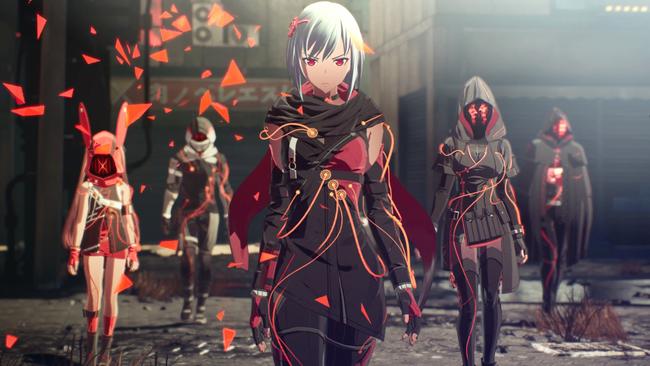
You are not left to fend for yourself on this dangerous world; a main theme of Scarlet Nexus that trickles down to the gameplay. As the narrative goes on, you’ll slowly recruit other characters to your team. Each of them have their own unique power, and if you strengthen your bonds with them, you can use their powers in battle even if you don’t control these characters directly. When you fully assemble your party and have all of your abilities unlocked, Scarlet Nexus’ combat was some of the most enjoyable I’ve seen in recent years. It rides the line between style and function successfully, and every time it clicked I found myself having immense amounts of fun. While your swings can feel as if they lack weight and attacks seem to whiff more often than I hoped, the focus on pure speed makes up for this. You dash and weave through enemies, needing to make split second decisions to handle every foe. The flow of battles was really unlike anything I’ve played. Frantic yet strategic, Scarlet Nexus in a nutshell.
The failures do not lie entirely with the combat system itself, but with many of the aspects surrounding it. The biggest flaw is easily how frequently it reuses content. I’m no stranger to the difficulties of game design. Video games cost money, and a lot of it. We also are still living through a truly horrible global pandemic. Scarlet Nexus is a new IP, and as much as Bandai seems to be giving it their all with promotion, it was certainly a risk. I would have preferred a more concise experience than one that stretched itself out so thin. Throughout a 25 hour playthrough, I found myself having to revisit many dungeons several times over. The reason for doing so never really felt justified, as much as the narrative tries to. Enemy variety is also especially weak, having you frequently deal with several of the same, most-annoying monsters at you in droves in the final chapters.

However, calling the dungeons and enemy design superb would be an understatement. Every area you explore has striking visual design, some of the best I’ve ever seen in an action game. They’re all distinct and a wonder to explore, despite some falling back on being a bit too linear as you traverse through them. The Others that populate these spaces are designed to look truly grotesque and off-putting. They stand out immediately and stick with you after you hit credits. The problem is that no matter how high quality these two aspects are in a vacuum, my appreciation could only wane the more I saw them reused again and again. So many little moments of repetition add up and dilute the brilliant combat system that exists at its core.
There are two ways you can defeat Others: 1.) by reducing their health to zero or 2.) by reducing their “stamina” to zero and attacking them with a Brain Crush. If the latter happens, you have to press the left trigger and do an animation. While I was initially impressed with how many different ones were made, by the end of my playthrough I found myself tired with how often they broke up the flow of battles. Brain Crushes are also crucial for boss battles, which are another thing I’m quite mixed on.

Bosses start enjoyable enough, but by the end most of them are damage sponges. The boss fights with human opponents, which should be enjoyable since you’re up against people with similar abilities as you, felt a bit messy. Your main defensive option is dodging, and if you pull it off within a very precise window you can perfectly dodge and retaliate. During these battles however, I frequently found myself dodging one attack and going right into another attack. Even though I made sure to keep up with optimizing my parties’ equipment whenever more unlocked, bosses felt like they hit too hard and took too long to beat. Defeating them feels rather formulaic, with you chipping away at their stamina until you can hit them with brain crush around two times.
While my thoughts sound overall very negative, I still think positively about the battle mechanics as a whole. Scarlet Nexus looks and feels great to play, accented by stunning battle animations that don’t take away from fluidity. You’re given some freedom to build your protagonist how you see fit, and this worked wonderfully for me. You start with an incredibly limited move set, but as you gain levels and grow closer with those around you the combat systems really open up. You gain BP with each level, and can spend those in the Brain Map section of your main menu. Outside of equipment customization, this is where most of the RPG elements exist. There are several branches you can go down to gain new abilities, and this was something I personally love in Action RPGs. Do you want to spend your points on a new movement ability or a passive buff? Do you want to blow your points on minor upgrades or save them up for a powerful combo extender? This isn’t a revolutionary new feature, but I think it works exceptionally well with the theme of the two protagonists needing to mature and grow into their roles to protect the ones they care about.

Scarlet Nexus’ experience is obviously more than an endless series of battles, something it reminds you of regularly. When you aren’t exploring dungeons you’re taking part in the story or engaging with side activities. I don’t want to get too much into the story because it's incredibly dense, nearing convoluted, and very easy to spoil. It brings up numerous commonly used science fiction tropes and ideas, and it can frankly be overwhelming at the start. Mysteries are stacked on top of one another with each chapter that passes, but what truly surprised me was seeing how well it wrapped itself up by the end. There are extremely mature takes on the themes of loss and regret and how they’d mingle amongst a world where sci-fi concepts could easily exist as an “easy solution”. You can tell just how excited the writers were to tell this story, and it really shows. I was genuinely surprised by the end with how strongly the the story stuck the landing despite how much I wasn’t expecting it to. Few games like this tend to pull of a strong conclusion, and Scarlet Nexus does so with ease. I think the content of the story is executed strongly by the time the narrative wraps itself up, but the uneven presentation of that story itself leaves something to be desired.
This is helped by a solid voice cast in both english and japanese. There is a great deal of dialogue, and I was happy to see almost all of it was voiced. I played in English and felt that the cast did a rather great job. I’m not sure if the voice work was done before or during the pandemic, but the fact that I wasn’t able to tell says enough about how good it all sounded.

Fully animated cutscenes exist using wonderful anime-like 3D character models, and they honestly look absolutely incredible, but the reality of it is that they’re sparse. A majority of cutscenes exist as static images of the characters, with portrait windows of the character models appearing on top of them for dialogue. These windows move something like a motion comic, with panels moving in and out of the frame to depict movement in sequences despite no actual animation happening. Oddly enough the characters will change appearance based on the costumes you put on them, so these aren’t actual images being used despite that seeming to be the case. You get used to it over time, but it doesn’t mean it isn’t cluttered.
I know this had to have been due to budgetary restraints so it’s impossible for me to really be mad at the decision to present the story like this, but it can take away from the impact of many action heavy scenes. Any emotional scene using these also loses something, because the character models in the portraits show next to no emotion. For this reason I’m actually pretty excited for that upcoming anime adaptation, because I feel it could breathe a lot of life into how the story presents itself.
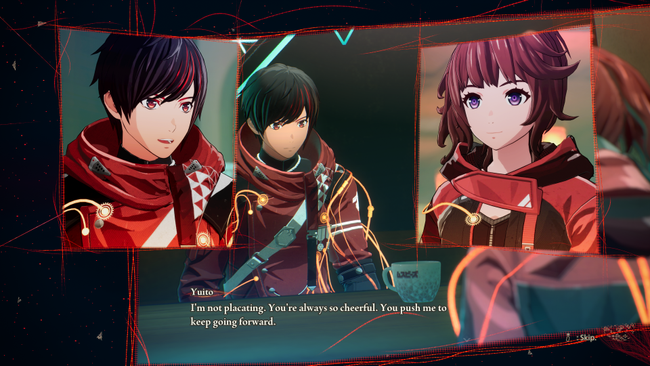
Between each chapter you are given a breather with Standby Phases. During these, you and your active party will spend time relaxing at your platoon’s hideout. What these segments are really for is the Bonding System. (Well, for side quests as well, but those were rather unmemorable and the rewards make them not really worth doing.) It has become rather common for JRPGs these days to have some variety of this mechanic. You know what? That’s totally fine. In Scarlet Nexus’ case, it adds significantly to both the themes and core combat mechanics. The closer you get with your platoon the better they work as a team, and you can do this by giving them gifts and viewing their bonding events.
While the rate at which gifts unlock in the store was unevenly paced, I loved seeing how they would be immediately added to the hideout. As you get closer with your friends, the bleak three rooms you all spend time in between missions starts to become full of life. The more comfortable they get with you, the more your shared abilities improve. These can mean they merely appear to protect you from certain hits, allow you to use them for longer, or even summon your friends to do special attacks based on what's happening in battle. The contents of these bonding events are also rather enjoyable. It’s nice to see your party engage in activities where they lower their guard and show their real selves. Much of the best story content in the whole game for me came from the bonding events, because it expands the world in ways you don’t get from the main campaign.
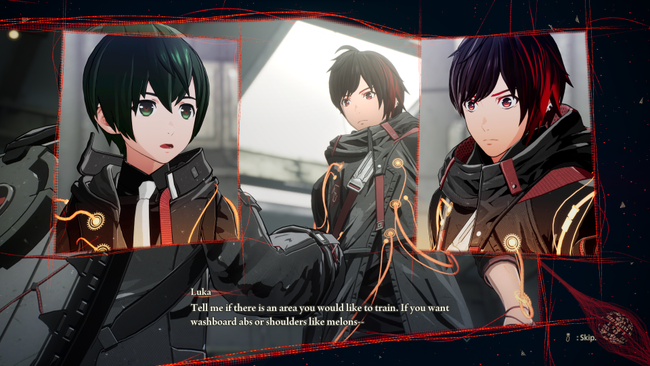
The problem of these Bonding Events is that they often clash with what's happening in the main story and when this happens the stakes are shattered. Without getting into spoilers, which admittedly would give the context I need to explain the following points, there comes a part where bonding events severely take away from the overall story. Certain character motivations are brought into question because it makes no sense why they would take the time to go on a dinner date with the protagonist at that point in time in the main narrative. Because Scarlet Nexus abides by a strict formula of needing to return to the hideout to bond with your friends, the middle set of chapters frequently undoes seemingly massive changes in the world as soon as they are introduced to return everything to the status quo. To many people this wouldn’t matter, and I’ve basically considered them a massive nitpick for myself. Bonding events add to the narrative more than they take things away, and by the end I found myself impressed with how strong the cast was.
To get more technical, my time playing on Playstation 5 was great but there wasn’t much about the game that made me feel this version was next gen. Pop-in was a regular occurence, but the performance was perfect. I never saw the framerate drop below 60 fps, even when I was playing it at maximum resolution possible. The biggest reason I’d say Scarlet Nexus is worth getting on PS5 is the haptic feedback. You can feel slight resistance on the trigger whenever you pick up an object to throw, or nothing if you run out of meter. It’s a little detail, but it added a lot to the experience.

Scarlet Nexus is an easy game to enjoy and a hard one to hate. It’s so unabashedly earnest about everything it set out to do that even with my issues I couldn’t help but reflect fondly back on my time playing. Most of what it tries to accomplish is done so adequately or successfully, which means a majority of what I had to discuss were parts that broke me out of the vibes presented to me. The combat is free form and incredibly creative, the visuals might be some of the finest to ever come from Bandai Namco, and the story is dense yet largely satisfying. There is fantastic framework in place now for a sequel, and I hope it sells enough so this team can continue to flesh out their vision. The budget was put mainly into nailing the style they were going for, and therefore padding was likely deemed necessary to fill out the length. This was truly unfortunate, but if you can look past this you’ll that nearly every facet of it is overflowing with passion. It’s the kind of game that only improved the more I thought about it, and I can’t wait to see where this team will go next.
Although, I do have a big issue with one thing in particular. An issue so massive it ruined my experience. News articles before release repeatedly reported that a certain character’s name was Cullen Travers. As a Cullen myself, I found myself over the moon with excitement. You don’t really ever see Cullens in video games, especially ones in Japan. I even took on this assignment just to get to say I reviewed a game with a Cullen in it. His name was unfortunately localized as Karen Travers. Maybe this could have been a mistranslation for western news sites, but I still think Cullen would have been an overall better name. My mother gave me this name for a reason, Bandai Namco. Are you trying to tell me my mother raised a Karen? Anyway, good job overall. I’ll probably check out the anime.
